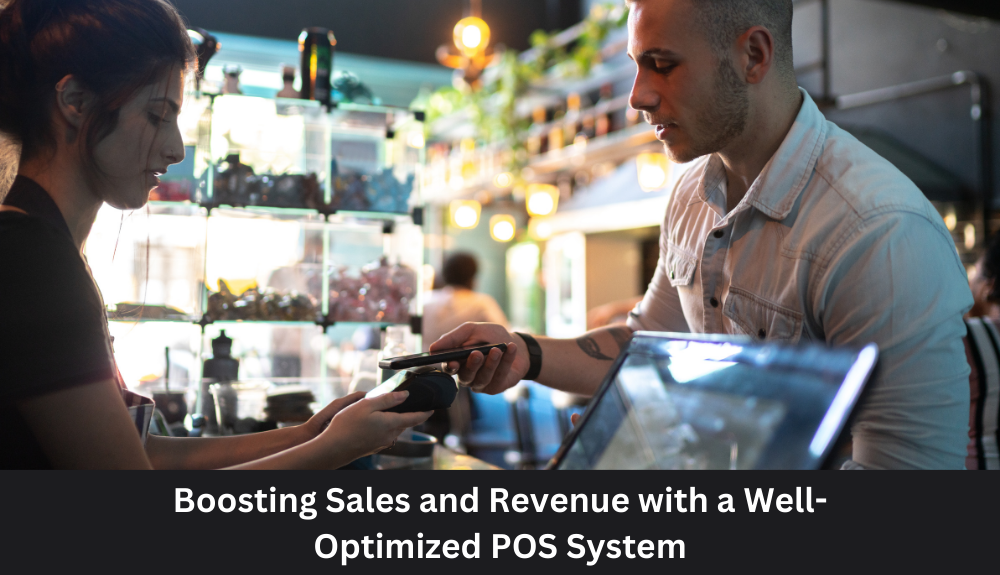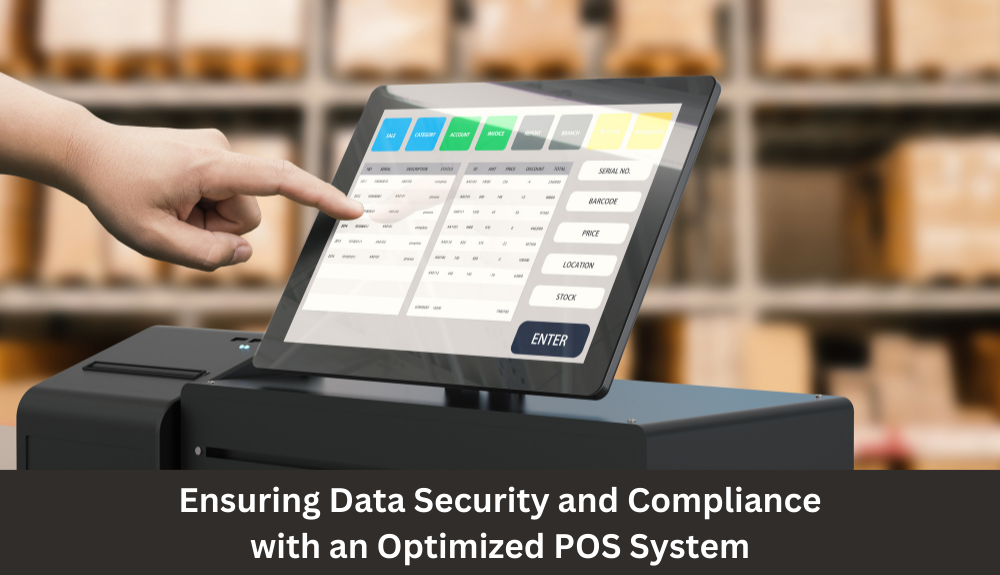Supercharge Your Restaurant’s Performance: The Benefits of Optimizing Your Point of Sale System

Breaking Boundaries: The Top Worldwide Payment Trends to Watch in 2023
November 28, 2023
10 Must Have Call Center CRM Software for Exceptional Customer Experience in 2024
December 1, 2023Have you ever wondered how to take your restaurant’s performance to the next level? Look no further than optimizing your point of sale (POS) system. In today’s fast-paced and competitive industry, having an efficient and streamlined POS system can make all the difference. It not only improves operational efficiency but also enhances the overall guest experience, leading to increased customer satisfaction and loyalty.
But what exactly are the benefits of optimizing your restaurant’s POS system? In this informative and in-depth blog, we will dive into the various advantages that come with fine-tuning your POS system. From faster order processing and accurate inventory management to seamless integration with other tools and enhanced data analytics, we will explore how optimizing your POS system can supercharge your restaurant’s performance. So, whether you’re a small café or a large-scale eatery, get ready to discover the power of an optimized POS system and how it can elevate your business to new heights.
1. Understanding the Point of Sale (POS) System
In the fast-paced and competitive world of the restaurant industry, optimizing your point of sale (POS) system can be a game-changer for your business. A POS system is the central hub where all transactions take place, from taking orders to processing payments. It not only streamlines your operations but can also have a significant impact on your restaurant’s performance, customer experience, and overall profitability.
Benefits of a Modern POS System:
1. Enhanced Efficiency: A modern POS system offers features that can streamline your restaurant’s operations and boost efficiency. With features like tableside ordering and online ordering integration, your staff can serve customers faster and with greater accuracy. This streamlines the entire ordering process, reduces wait times, and improves table turnover, leading to higher revenue.
2. Improved Customer Experience: A reliable POS system can greatly enhance the customer experience. Tableside ordering allows customers to place their orders directly with the waitstaff, eliminating the need for them to wait in long queues or catch the attention of busy servers. This not only saves time but also gives customers a personalized and efficient dining experience.
3. Accurate Inventory Management: Keeping track of inventory is crucial for any restaurant. A modern POS system can automate inventory management, helping you accurately track ingredient usage, monitor stock levels, and predict when to reorder. This ensures that you never run out of popular menu items, minimizes waste, and reduces costs.
4. Streamlined Reporting and Analytics: A POS system collects and analyzes data from various aspects of your restaurant’s operations. This data includes sales figures, customer behaviors, and employee performance. With comprehensive reporting and analytics, you can gain valuable insights into your restaurant’s performance, identify areas for improvement, and make data-driven decisions to maximize profitability.
5. Integrated Loyalty Programs and Marketing Campaigns: Many modern POS systems offer integrated loyalty programs, allowing you to reward and retain your regular customers. By tracking customer preferences and purchase history, you can create targeted marketing campaigns to drive repeat business and boost customer loyalty. This personalized approach can significantly enhance customer satisfaction and increase revenue.
💡 key Takeaway: Optimizing your point of sale (POS) system can lead to enhanced efficiency, improved customer experience, accurate inventory management, valuable reporting and analytics, as well as integrated loyalty programs and marketing campaigns. Investing in a modern and reliable POS system enables your restaurant to operate at its full potential, maximize profits, and gain a competitive edge in the ever-evolving restaurant industry.
2. Why Optimizing Your POS System is Essential for Restaurant Owners
Optimizing your point of sale (POS) system is essential for restaurant owners who want to supercharge their business performance. With the right POS system in place, you can streamline operations, enhance customer experiences, and ultimately boost your bottom line. Let’s explore why optimizing your POS system is a crucial step for restaurant owners looking to stay competitive in the industry.
1. Efficient Order Management:
An optimized POS system allows restaurant owners to efficiently manage orders, ensuring smooth operations during peak hours. With features like menu item customization, order modifiers, and real-time updates, you can streamline the ordering process and minimize errors. Staff can quickly relay orders to the kitchen staff, reducing wait times and improving overall efficiency.
2. Enhanced Customer Experience:
A well-optimized POS system enables you to provide a seamless and personalized customer experience. With features like loyalty programs and customer profiles, you can track customers’ preferences, offer personalized promotions, and create a more engaging dining experience. By understanding your customers better, you can tailor your offerings to their needs and preferences, fostering loyalty and satisfaction.
3. Streamlined Operations:
Optimizing your POS system allows you to streamline your entire restaurant’s operations. Features like tableside ordering, online ordering, and integrated payment processing facilitate a smoother workflow, reducing manual tasks and human errors. Your kitchen staff can receive orders directly through the POS system, minimizing communication gaps and ensuring faster ticket turnaround times. Additionally, an efficient POS system enables you to manage your inventory effectively, ensuring you never run out of stock for popular menu items.
4. Improved Financial Management:
A well-optimized POS system provides valuable insights into your restaurant’s financial performance. You can easily track sales data, monitor profit margins, and identify trends. With robust reporting capabilities, you can gain a comprehensive overview of your restaurant’s total expenses, labor costs, and other key financial metrics. This information empowers you to make data-driven decisions and implement strategies that can significantly impact your bottom line.
5. Marketing Opportunities:
Optimizing your POS system opens up new marketing opportunities for your restaurant. By leveraging customer profiles and purchase histories, you can launch targeted marketing campaigns, offer personalized promotions, and attract regular customers. You can also identify special occasions like birthdays or anniversaries and send customized offers or incentives
3. Enhancing Customer Experience through the POS System
When it comes to running a successful restaurant, enhancing the customer experience should be a top priority. One way to achieve this is by optimizing your point of sale (POS) system. A well-implemented POS system can have a significant impact on customer satisfaction and overall restaurant performance. Let’s explore the various ways in which a properly utilized POS system can enhance the customer experience.
1. Streamlined Ordering Process:
A modern POS system can revolutionize the way orders are taken and processed in your restaurant. With features such as tableside ordering and online ordering integration, you provide customers with a seamless and convenient way to place their orders. This not only reduces wait times but also minimizes the chances of errors, ensuring accurate and efficient service.
2. Enhancing Menu Item Customization:
With a reliable POS system, restaurant owners can easily modify menu items to accommodate customer preferences and dietary restrictions. This allows for a more personalized dining experience, increasing customer satisfaction and loyalty. Whether it’s adjusting ingredients, portion sizes, or offering substitutions, a POS system empowers your establishment to deliver a tailor-made experience to every customer.
3. Efficient Customer Service:
Customer service is a vital aspect of any restaurant, and a properly utilized POS system can greatly improve those interactions. By utilizing features such as customer profiles, previous order history, and loyalty program integration, your staff can provide personalized service that caters to individual preferences. This level of attention enhances the overall dining experience and fosters customer loyalty.
4. Innovative Payment Solutions:
In today’s digital age, customers expect convenient and secure payment options. A modern POS system offers various payment methods, including credit card processing, tableside payments, and even integration with mobile wallet platforms. By providing customers with a range of payment options, you streamline the checkout process and create a positive impression of your restaurant.
5. Effective Inventory Management:
A POS system can also greatly impact behind-the-scenes operations by optimizing inventory management. By automating the tracking of sales data and monitoring stock levels, you can ensure that popular menu items are always available and promptly restocked. This minimizes instances of low stock, helps prevent missed opportunities, and improves overall customer satisfaction.
💡 key Takeaway: Implementing a modern POS system can enhance the customer experience in numerous ways, including streamlined ordering processes, menu item customization, efficient customer service, innovative payment solutions, and effective inventory management.
4. Increasing Efficiency and Streamlining Operations with the Right POS Solution
A modern restaurant POS system plays a crucial role in enhancing efficiency and streamlining operations. By choosing the right POS solution for your restaurant, you can optimize various aspects of your business and unlock its full potential. Let’s explore the key benefits of implementing the right POS system.
1. Improved Order Accuracy and Speed:
With a reliable POS system, your kitchen staff can seamlessly receive orders and data from the servers. The system allows for accurate and swift communication, reducing the chances of manual errors. By eliminating the need for handwritten tickets and minimizing human error, your restaurant can significantly improve its order accuracy and speed. This, in turn, leads to increased customer satisfaction and repeat business.
2. Enhanced Customer Service:
A modern POS system enables your staff to provide exceptional customer service. It allows for efficient order taking, making modifications to menu items, and handling special requests with ease. Additionally, a POS system with tableside ordering capabilities empowers your staff to take orders directly from the table, eliminating the back and forth between the table and POS terminal. This not only minimizes wait times but also enhances the overall dining experience for your customers.
3. Integrated Inventory Management:
Managing your restaurant’s inventory can be a complex task. However, the right POS solution simplifies this process by integrating inventory management features. It enables you to track ingredients, monitor stock levels, and receive automated alerts when supplies are running low. With real-time updates on inventory, you can avoid stockouts, maintain a well-stocked kitchen, and minimize wastage. By optimizing inventory management, you can effectively control your restaurant’s total expenses and maximize your profit margin.
4. Streamlined Reporting and Analytics:
A modern POS system provides comprehensive reporting and analytics capabilities, offering valuable insights into your restaurant’s performance. From sales data to customer behavior, a reliable POS solution allows you to access detailed reports that help you make informed decisions. You can analyze key metrics, such as revenue by menu item, peak hours, and customer preferences, to optimize your menu, marketing campaigns, and overall business strategy.
5. Efficient Staff Management:
With the right POS system, managing your restaurant’s staff becomes more efficient. The system allows you to track employee performance, manage shifts, and monitor labor costs. Additionally, you can implement loyalty programs and reward systems through your POS system, encouraging employee motivation and enhancing customer loyalty.
5. Boosting Sales and Revenue with a Well-Optimized POS System

A restaurant’s point of sale (POS) system is more than just a tool for processing payments. When optimized effectively, a modern POS system can significantly boost sales and revenue. Let’s explore how implementing a well-optimized POS system can have a positive impact on your restaurant’s performance:
Streamlined Menu Item Management:
A well-optimized POS system allows you to easily manage your menu items. With a few clicks, you can update prices, add descriptions, and modify options for different menu items. This flexibility enables you to quickly respond to customer preferences, changes in ingredient availability, or market trends. By keeping your menu updated and appealing, you can entice customers to try new dishes and increase their overall satisfaction.
Enhanced Customer Experience:
Providing exceptional customer experience is crucial for restaurants to thrive. A well-optimized POS system can contribute to a seamless dining experience. With features like tableside ordering and online ordering integration, you can reduce wait times, minimize human errors, and enhance order accuracy. This level of efficiency ensures a smooth and satisfying experience for your customers, leading to increased customer satisfaction and loyalty.
Improved Inventory Management:
Maintaining optimum ingredient stock levels is essential for smooth restaurant operations. A well-optimized POS system can track inventory in real-time, alerting you when stock levels are running low. This feature enables you to reorder ingredients promptly, reducing the chances of running out of popular items and minimizing potential revenue loss. By effectively managing inventory, you can optimize costs and ensure that your kitchen staff can fulfill customer orders without delay.
Effective Marketing Campaigns:
A well-optimized POS system can provide valuable insights into your customers’ preferences and behaviors, allowing you to create targeted marketing campaigns. By leveraging the sales data provided by your POS system, you can identify top-selling items, popular dishes, and customer trends. This information empowers you to design personalized promotions, loyalty programs, and special offers tailored to your customer’s preferences. By delivering targeted marketing campaigns, you can attract new customers, retain existing ones, and ultimately boost sales and revenue.
6. Improving Inventory Management and Reducing Costs
Effective inventory management is crucial for any restaurant to succeed. By optimizing your point of sale (POS) system, you can streamline your inventory processes, reduce costs, and improve overall efficiency. Here’s how:
1. Accurate Tracking of Menu Items:
A modern POS system enables restaurant owners to easily track each menu item’s popularity and sales data. With this information at your fingertips, you can make data-driven decisions about which items to keep, promote, or remove from your menu. By eliminating underperforming dishes and focusing on the ones that generate the most revenue, you can optimize your menu and minimize wasted inventory.
2. Streamlined Ordering Process:
With a restaurant POS system, you can automate and streamline the ordering process. Integrated features like tableside ordering or online ordering allow customers to place their orders directly, eliminating the need for manual communication between servers and kitchen staff. This ensures accuracy, reduces human error, and saves time, enabling your team to focus on providing a seamless dining experience.
3. Real-Time Inventory Tracking:
Cloud-based POS systems provide real-time inventory tracking, giving you instant visibility into your stock levels. You can set up alerts for low stock items, preventing situations where you run out of essential ingredients during busy periods. Real-time tracking also helps prevent overstocking, minimizing waste and optimizing your restaurant’s total expenses.
4. Integrated Supplier Management:
Many modern POS systems come with integrated supplier management features. They allow you to keep track of your suppliers, manage orders, and receive automatic updates on pricing and availability. By establishing strong relationships with reliable suppliers, you can ensure a steady supply chain and negotiate better deals, further reducing your restaurant’s costs.
5. Minimized Labor Costs:
An efficient POS system can also help streamline your restaurant’s operations, reducing the need for excessive labor. With features like tableside ordering and self-service kiosks, you can optimize the workflow and require fewer staff members to handle orders. This not only saves on labor costs but also improves the overall efficiency of your team.
💡 key Takeaway: Optimizing your point of sale system and inventory management can lead to cost reductions, increased efficiency, and improved customer satisfaction in your restaurant.
7. Minimizing Human Errors and Enhancing Accuracy through POS Optimization
When it comes to running a restaurant, accuracy and efficiency are essential. The last thing you want is for human errors to impact your operations, resulting in dissatisfied customers, wasted inventory, and potential financial losses. That’s where optimizing your point of sale (POS) system can make a significant difference. By leveraging the capabilities of a modern POS solution, you can minimize human errors and enhance accuracy throughout your restaurant’s operations.
1. Streamlined Order Taking and Processing
With a properly optimized POS system, your staff can take orders efficiently and accurately. By using a tablet-based POS solution with tableside ordering capabilities, servers can input orders directly into the system at the table, eliminating any potential for miscommunication or errors that may occur during the traditional order-taking process. This streamlines operations, reduces order mistakes, and ensures that customers receive the correct items.
2. Inventory Management and Low Stock Alerts
A reliable POS system can help you keep track of your inventory in real-time. By integrating your POS system with your kitchen and bar, you can automatically update inventory levels as orders are placed, reducing the risk of running out of popular menu items unexpectedly. With low stock alerts, you can proactively restock ingredients before they become unavailable, ensuring uninterrupted service and preventing any disappointments for your customers.
3. Accurate Billing and Payment Processing
One of the most critical aspects of customer satisfaction is accurate billing. With a modern POS system, you can eliminate the risk of miscalculations or missed items on the bill. The system will automatically calculate the total amount owed, including taxes and gratuities, reducing the chances of errors that may occur in manual calculations. Additionally, the integration of secure credit card processing ensures that payments are processed accurately, eliminating potential payment issues.
4. Enhanced Reporting and Analytics
A well-optimized POS system enables you to gather valuable sales data and generate insightful reports. By analyzing these reports, you can gain a clear understanding of your restaurant’s performance, identify trends, and make informed decisions to boost your revenue and efficiency. Accurate data and analytics provide you with the information you need to optimize your menu items, refine your marketing campaigns, and improve overall profitability.
💡 key Takeaway: Optimizing your point of sale system helps minimize human errors, streamline order taking, manage inventory effectively, ensure accurate billing, and provide valuable insights through enhanced reporting and analytics.
8. The Role of Data Analytics in Maximizing Performance
In today’s competitive restaurant industry, staying ahead of the game requires more than just great food and excellent service. Restaurant owners must also harness the power of data analytics to make informed decisions and maximize performance. By leveraging data from their point of sale (POS) system, restaurants can gain valuable insights that can improve various aspects of their operations.
1. Tracking Menu Item Performance
One of the key benefits of data analytics in the restaurant industry is the ability to track the performance of menu items. By analyzing sales data, restaurant owners and managers can identify the most popular dishes and understand customer preferences. This information can inform menu changes, promotions, and even determine which ingredients are most cost-effective.
2. Optimizing Customer Experience
Data analytics can also be used to improve the overall customer experience. By analyzing customer feedback and behavior data, restaurant owners can identify patterns and trends that can help enhance service, ambiance, and overall satisfaction. For example, if the data indicates that customers often complain about slow service during peak hours, management can schedule additional kitchen staff or implement tableside ordering to improve efficiency.
3. Enhancing Marketing Campaigns
Understanding customer demographics and preferences is crucial for designing effective marketing campaigns. Data analytics can provide insights into customer behavior, allowing restaurant owners to personalize offers and promotions based on individual preferences. By tailoring marketing efforts to specific customer segments, restaurants can increase customer engagement and loyalty.
4. Optimizing Inventory Management
Having the right amount of stock on hand is vital for maintaining a smooth operation and minimizing wastage or stockouts. Data analytics can help identify consumption patterns and predict demand, enabling restaurants to optimize inventory levels. By closely monitoring inventory data, restaurant owners can ensure that popular dishes are always available while reducing storage costs and waste.
5. Streamlining Labor Costs
Labor costs are a significant expense for restaurants, and finding the right balance is crucial. Data analytics can help in scheduling shifts, optimizing staffing levels, and even identifying opportunities for cross-training employees. By analyzing sales data and customer demand, restaurant owners can make data-driven decisions to streamline labor costs without compromising customer service.
6. Driving Profit Margins
Ultimately, the goal of any restaurant is to generate profits. Data analytics can provide insights into how various factors, such as pricing strategies, menu changes, or the implementation of a loyalty program, impact overall profitability.
9. Ensuring Data Security and Compliance with an Optimized POS System

Data security and compliance are critical considerations for any restaurant owner in today’s digital landscape. With an optimized Point of Sale (POS) system, you can safeguard your restaurant’s sensitive information and ensure that you meet industry regulations. Let’s explore some key strategies and features that can help you achieve data security and compliance with your POS system.
1. Secure Payment Processing:
A modern POS system offers secure payment processing, ensuring that your customers’ credit card information and personal data are protected. By using encrypted transactions and adhering to Payment Card Industry Data Security Standard (PCI DSS) regulations, you can minimize the risk of data breaches and maintain the trust of your customers.
2. User Access Controls:
Controlling access to your POS system is crucial for maintaining data security. With an optimized POS system, you can implement role-based user access controls, limiting staff members’ access to sensitive information. This ensures that only authorized personnel can view and modify data, reducing the risk of internal data breaches.
3. Data Encryption:
Encryption is a powerful security measure that helps protect your restaurant’s data from unauthorized access. An optimized POS system encrypts data both in transit and at rest, making it extremely difficult for cybercriminals or unauthorized individuals to decipher the information. This encryption provides an additional layer of security to safeguard your customer’s personal and financial data.
4. Regular Software Updates:
Staying up-to-date with the latest software updates is crucial in maintaining data security and compliance. Opt for a POS system that offers regular updates and patches to address any vulnerabilities or security loopholes. By keeping your POS software current, you can ensure that you have the latest security features and protect your systems from potential threats.
5. Compliance with Data Privacy Regulations:
To avoid legal and financial consequences, it’s essential for your restaurant to comply with data privacy regulations like the General Data Protection Regulation (GDPR). An optimized POS system can help you manage customer data in line with these regulations, ensuring that you obtain proper consent and handle data securely and transparently.
6. Data Backup and Disaster Recovery:
In the event of an unforeseen incident, such as a power outage or system failure, having reliable data backup and disaster recovery mechanisms in place is crucial. Ensure that your POS system offers automated backups and a robust disaster recovery plan to minimize downtime and protect your restaurant’s data from loss or corruption.
10. Harnessing the Power of a Well-Optimized POS System in the Modern Restaurant Industry
In today’s fast-paced restaurant industry, having a well-optimized Point of Sale (POS) system is crucial for maximizing efficiency, streamlining operations, and boosting overall performance. A modern restaurant POS system offers a wide range of benefits that can supercharge your restaurant’s success. Let’s dive in and explore how harnessing the power of a well-optimized POS system can revolutionize your business.
1. Streamlined Operations:
A well-optimized POS system simplifies and automates various aspects of your restaurant’s daily operations. From order management and inventory control to staff scheduling and reporting, a modern POS solution seamlessly integrates all these functions into one centralized platform. This integration eliminates the need for manual processes, reducing human error and saving valuable time.
2. Enhanced Customer Experience:
A key component of a successful restaurant lies in providing an exceptional customer experience. A well-optimized POS system enables you to offer tableside ordering, online ordering, and even personalized service with the help of a loyalty program. These features enhance customer satisfaction by reducing waiting time, ensuring accurate order fulfillment, and providing a seamless dining experience.
3. Real-time Sales Data:
Monitoring sales data in real-time is essential for effective decision-making and improving your restaurant’s performance. With a cloud-based POS system, you can access sales data, inventory levels, and other important metrics anytime, anywhere. This enables you to make informed decisions regarding menu items, pricing strategies, and marketing campaigns, ultimately driving revenue growth.
4. Efficient Restaurant Management:
Managing a restaurant involves numerous moving parts, and modern POS software simplifies the entire process. From tracking employee performance and managing labor costs to optimizing floor plans and table assignments, a well-optimized POS system provides comprehensive tools for effective restaurant management. With the right POS system, you can fine-tune operations, reduce overhead costs, and maximize your profit margin.
5. Accurate Inventory Management:
Keeping track of inventory levels can be a tedious and time-consuming task. However, with a reliable POS system, you can automate inventory management and receive low stock notifications. This ensures that you never run out of essential ingredients and supplies. A well-optimized POS solution helps you maintain optimal stock levels, minimizes wastage, and improves overall cost efficiency.
Conclusion
In conclusion, optimizing your restaurant’s point of sale system can have a significant impact on your overall performance. By streamlining operations, reducing errors, and improving customer service, you can supercharge your restaurant’s efficiency and profitability. One of the key benefits of a well-optimized POS system is the ability to efficiently track sales, inventory, and customer data. This data can provide valuable insights into customer behavior, enabling you to make informed decisions to better meet their needs and preferences. Additionally, an optimized POS system can help you identify and eliminate bottlenecks in your processes, ensuring a smoother operation and happier customers.




